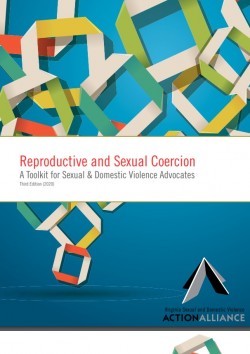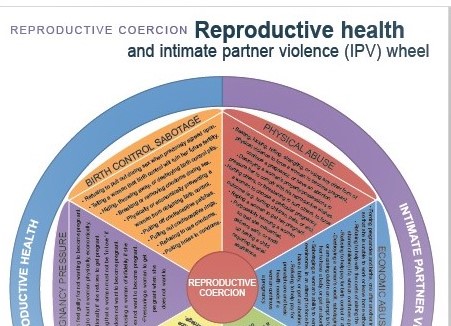Resources Library: Tools
Start a Search:
Reproductive and Sexual Coercion: A Toolkit for Sexual & Domestic Violence Advocates

The Virginia Sexual and Domestic Violence Action Alliance seeks to build local sexual and domestic violence agencies’ capacity to identify reproductive and sexual coercion. This includes: implementing screening for reproductive and sexual coercion, implementing policies and procedures that address reproductive and sexual coercion, fostering partnerships with family planning and reproductive health providers, and doing the above-mentioned work through a reproductive justice framework or lens.
The goal of this toolkit is to help begin conversations and implement new or clarify existing policies within your agency: What is reproductive and sexual coercion? Why is a reproductive justice framework necessary? How can we best support survivors of sexual and intimate partner violence with a better understanding of reproductive and sexual coercion? What are sample policies and procedures my agency can utilize? Who in my community can I collaborate with on this work? We hope this resource provides some answers to these questions while also guiding and supporting further learning on these topics to best support the specific needs of your community.
Reproductive Health and Intimate Partner Violence Wheel

Reproductive Health and Intimate Partner Violence Wheel provides definitions and examples of reproductive coercion and intimate partner violence. The wheel can be used as a training tool for advocates and service providers, as well as a supportive and enlightening resource for survivors.
Resources Addressing the Unique Needs of Black and Latin@ LGBQ/T Survivors of Partner Abuse

TOD@S (Transforming Ourselves through Dialogue, Organizing, and Services) is an interagency collaboration between The Hispanic Black Gay Coalition, The Violence Recovery Program at Fenway Health, The Network / La Red, and Renewal House (a program of the Unitarian Universalist Urban Ministry) in Boston, Massachusetts. Their mission is to improve and increase access to intervention and prevention services for Black and Latin@ lesbian, gay, bisexual, transgender, and queer (LGBTQ) people affected by partner abuse.
They have created a Community Needs Assessment and Action Plan as well as a training for community service providers.
Sample Supplemental Domestic Violence and Strangulation Report Forms for Law Enforcement
These documents are samples of supplemental report forms that law enforcement agencies can use when documenting domestic violence and/or strangulation incidents. These forms are samples and intended to provide a framework that and local law enforcement agencies and community teams can adapt for their own use.
Technology and Abuse in Later Life
Technology is an invaluable resource for older survivors. Individuals may use the Internet, for example, to find support and cope with issues of abuse in later life. Yet, abusers can misuse technology as a tactic of abuse, which can be dangerous and potentially lethal.
In December 2014, with help from Disability Rights Wisconsin, End Domestic Abuse Wisconsin and the Safety Net Project of the National Network to End Domestic Violence, NCALL released this toolkit for older adults with two goals in mind: to provide information about common technologies, including assistive technology, and to identify ways older adults can safeguard themselves from those who misuse technology to control, harass, stalk, and/or threaten them. The toolkit contains the following:
1. Tech 101: Frequently Used Terminology – a glossary of tech terms, many of which are referenced in the toolkit.
2. Tech Tips for Older Adults: Tech Safety – a general overview of computer, cell phone and Internet safety.
3. Tech Tips for Older Adults: Online Privacy & Safety – An overview of the importance of online privacy and strategies for maintaining privacy and safety online.
4. Technology and Abuse in Later Life – An overview of the ways abusers misuse technology within the context of abuse in later life.
5. Assistive Technology – An overview of assistive technology, including what it is, who uses it and resources for finding out more about assistive technology.
6. Examples of Assistive Technology – An overview of assistive technologies for individuals who are Deaf or hard-of-hearing, have speech disabilities, are blind or have low vision, or have physical, motor or communication disabilities.
7. Assistive Technology and Abuse in Later Life – A general overview of the ways abusers may misuse assistive technologies to cause harm.
8. Tech Resources – A list of selected resources related to technology and technology safety.

